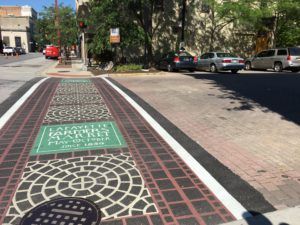Chelsea Schneider, Municipal Innovations Specialist
Lafayette city leaders wanted to give the downtown’s business corridor a fresh, distinctive look as a destination for residents and visitors alike. Today, all can see firsthand how that vision turned into reality.
Innovative streetscape improvements aim to create organic gathering places. Decorative pathways celebrate the city’s long-running farmers market. And towering sculptures enhance the downtown experience as visitors head to shops and restaurants.
For Mayor Tony Roswarski, the improvements play a vital role in restoring Downtown Lafayette as the community’s heart. As a boy, he remembers the past vibrancy of downtown, when residents came to shop at JCPenney’s or catch a show at the Mars Theatre. Those days were before more and more residents started moving into the suburbs, and Downtown Lafayette, like many places across the country, suffered and changed.
Roswarski set out to bring downtown back.
“We understand how important having a strong urban core is,” Roswarski said. “A strong downtown is not only felt downtown. It affects surrounding neighborhood stability and revitalization and the community as a whole. We knew having a strong urban core would do a lot, whether it was economic development, community development, retaining talent or the overall health of the economy.”
The project replaced sidewalks, some dating back to the 1940s, across more than six city blocks along Main Street. New concrete and brick pavers were installed, along with rain gardens near intersections to help control storm water runoff. The streets now feature a bump out design, with wider areas and rounded street corners where pedestrians can meet and other outdoor activity can occur.


With the work came a series of questions. What amenities do the citizens of Lafayette and the next generation want in a community? How does the city create entertainment venues, outside dining options and retail opportunities? How can public spending on infrastructure become a catalyst for private investment?
Already, the city is seeing that investment. A new luxury apartment complex, the MARQ, will bring 99 units and commercial space to the city’s riverfront, and other developments, including apartments in a renovated historic building, are planned as well. New restaurants also are popping up, including Pure Eatery and a new French restaurant under construction. Established restaurants are using the widened sidewalks to expand outdoor eating.
“This is a vibrant community and you need to create that sense of place that will lead to opportunities for art, restaurants and businesses to expand and grow,” said Brian Pohlar, project manager with HWC Engineering. “I think we’ve created that.”
The city received a tremendous amount of positive feedback from the work, said Dennis Carson, the city’s economic development director. During the planning process, the city directly engaged business owners and the public. The city also set up a website, www.downtownlafayetteisopen.com, and developed a marketing campaign, so community members and visitors knew businesses remained open during construction.
Funding for the project was made possible through tax-increment financing, a local development tool, and private property owners who paid for a portion of sidewalk and other streetscape improvements outside of downtown businesses.
“We wanted to get people out of their cars and into downtown with places to gather and linger,” Carson said. “They’re more likely to go up and down the street and look at what’s there.”
